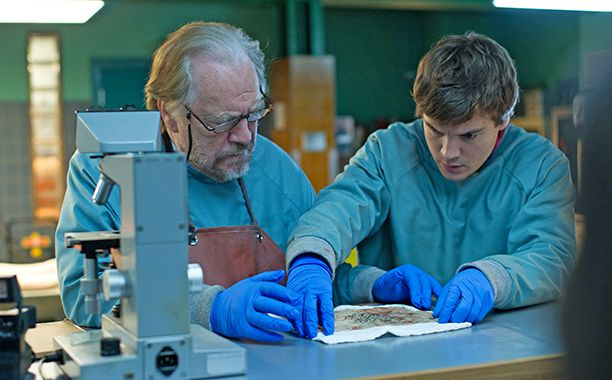Those who know me know that I am not a fan of horror movies. However, mistaken for a murder mystery - detective movie, I stumbled upon André Øvredal's 2016 horror film, "The Autopsy of Jane Doe," which transcends the genre's typical jump scares and gore. It delves into the psychological realm, exploring the anxieties surrounding death, the unknown, and the human desire for control. This analysis dissects the film through the lens of its characters, narrative choices, and the use of space, revealing a layered exploration of the human psyche.
Facing Mortality Through the Lens of Science and Belief
The film hinges on the dynamic between Austin Tilden (Emile Hirsch), a young, inquisitive medical examiner, and his father, Tommy Tilden (Brian Cox), a seasoned mortician with a stoic demeanor. Their contrasting personalities reflect the film's central thematic tension. Tommy, a man of science, seeks logical explanations, while Austin, though grounded in reality, holds a grudging respect for the unknown.
Tommy embodies a lifetime of confronting death. His experience has instilled a pragmatic acceptance, evident in his dry humor and unwavering focus on the task at hand. However, as the autopsy progresses and the strangeness of Jane Doe's body becomes undeniable, a flicker of unease crosses his face. This subtle shift hints at a deeper, unspoken fear – the fear that science might not have all the answers.
Austin, on the other hand, represents scientific naiveté. He approaches the autopsy with curiosity, eager to unravel the mysteries of the body. Yet, as the night unfolds and the scientific explanations fail to provide a complete picture, a sense of vulnerability creeps in. The autopsy becomes a confrontation not just with the physical aspects of death but also with the existential questions it raises.
Building Suspense Through the Unexplained
"The Autopsy of Jane Doe" unfolds within the confines of the Tilden family morgue. This single-location setting amplifies the claustrophobic atmosphere and fosters a sense of isolation. The audience is trapped alongside the characters, sharing their growing unease. The sheer atmosphere of the movie made me think to stop watching it at various times. I was just curious about how the director will conclude the story!
The film relies heavily on suggestion and atmosphere rather than overt displays of horror. The mystery surrounding Jane Doe's origins and the unsettling discoveries during the autopsy create a slow-burning dread. Øvredal masterfully utilizes sound design. The incessant hum of the refrigerator, the rhythmic thwack of the scalpel, and the eerie silence punctuated by unexplained noises build an atmosphere of unease.
The narrative unfolds through a series of discoveries during the autopsy. Each anomaly becomes a puzzle piece, further blurring the lines between scientific explanation and the supernatural. This piecemeal approach fuels the film's psychological horror, as the characters, and by extension, the audience, are bombarded with unsettling information with little context.
The film's climax is ambiguous, leaving the nature of the threat open to interpretation. I am taking the liberty to guess that, the creators of this movie intended this ambiguity to serve a dual purpose. It allows for individual interpretations, enhancing the film's rewatchability. More importantly, it reflects the human desire for control in the face of the unknown. By leaving the threat undefined, the film forces the audience to confront their own anxieties about death and the forces beyond our comprehension. For me, neither the climax nor the ambiguity worked out. It was just a "meh 🫤" moment when the credits started rolling.
The Morgue as a Psychological Landscape
The film utilizes the physical space of the morgue as a metaphor for the human psyche. The morgue is a sterile environment designed to control death. Yet, within its sterile confines, the characters confront a force that defies their attempts at control. As the autopsy progresses, the order of the room begins to unravel, mirroring the characters' deteriorating sense of control over the situation. Files are scattered, instruments are dropped, and the carefully maintained boundaries between life and death blur.
Furthermore, the film uses light and shadow strategically. The well-lit autopsy room represents the characters' initial sense of control. However, as the night progresses, shadows begin to dominate, creeping into the corners and concealing the source of strange noises. This increasing darkness reflects their growing fear and lack of understanding.
A Haunting Exploration of the Human Condition
"The Autopsy of Jane Doe" is more than a horror film; it explores human vulnerabilities psychologically. Through its somewhat compelling characters, a decently crafted atmosphere, and the symbolic use of space, the film delves into our anxieties surrounding death, the unknown, and the limitations of scientific understanding to a common man. It leaves us with lingering questions, not just about the specifics of the plot, but about the nature of reality itself. At least it looked like the creator intended to put out that line of thought and questions.
The film's ending is not a triumph or a resolution. Instead, it is a stark reminder that some things remain beyond our control, and that the human desire for order and explanation can be shattered in the face of the inexplicable. The same is what brought out the "meh" in me, as a person with a scientific temper. "The Autopsy of Jane Doe" may satisfy a naive person who believes in WhatsApp forwards, but not someone who can think.
To summarize; I chose to watch this movie because it was only one-and-a-half-hour runtime. And after watching the movie, I can surely say, I have successfully wasted that much time in my life. 👎🏼

Comments